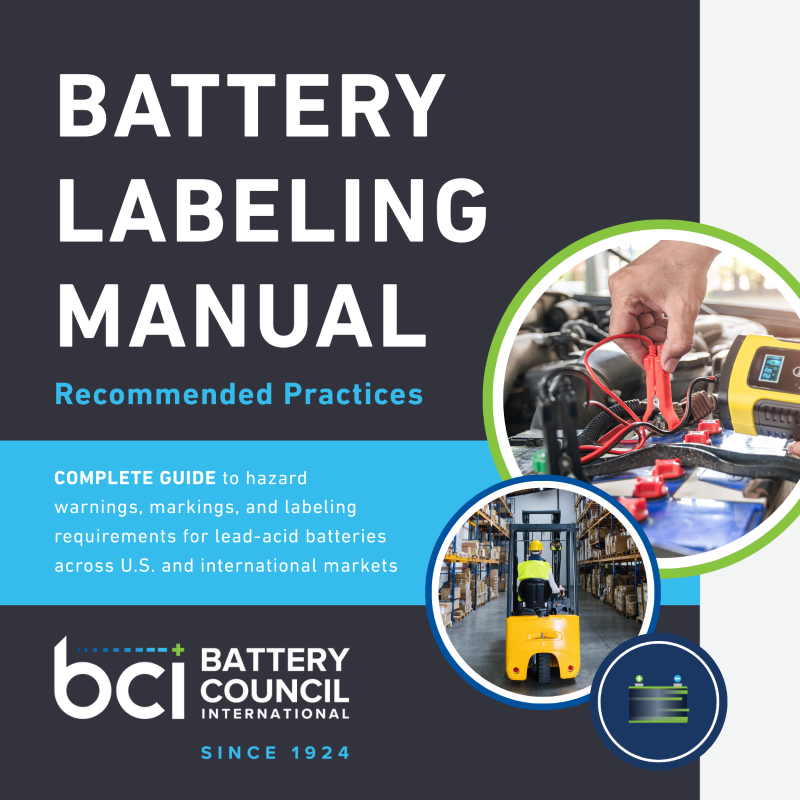This is a downloadable item. Once you complete your purchase, you will receive a download link via email.
Single-User License
The purchase of a PDF digital download grants the purchaser one single-user license to that document. This license is for use by one individual (either in digital or print form) and cannot be shared, or resold, in anyway. The digital file is copyrighted by BCI, all rights reserved.
Background and Introduction
The BCI Battery Labeling Manual outlines recommended practices and provides information on hazard warnings and other markings for lead batteries and packaging, as well as labeling and testing requirements for acid packs. It includes global standards and practices, reflecting major national and international laws and regulations governing health, safety, and the environment. The manual also offers relevant translations in Spanish and French.
The latest edition, published in September 2025, includes warnings required under California’s Proposition 65, along with labeling considerations for jurisdictions across the European Union and Asian markets including China and Japan.
Disclaimer
While recommended labels and warning messages included in this Manual are the result of extensive practical experience, consumer research, and legal analysis by Wiley Rein LLP, no warning can address every conceivable possibility. Use of the recommended labels and messages by manufacturers or sellers is voluntary, but recommended. The Battery Council International, Wiley Rein LLP, and the authors and reviewers of this manual expressly disclaim any liability, including, but not limited to, consequential or other damages, arising out of the use of these recommended labels and/or warnings. The information provided in this Manual does not constitute legal advice, and any legal questions should be directed to your legal counsel.
Price: $1,129.00
Member Price: $149.00
TABLE OF CONTENTS
CHAPTER 1 BACKGROUND AND INTRODUCTION
CHAPTER 2 CLASSIFICATION OF BATTERY MARKETS AND CALIFORNIA PROPOSITION 65
Section 2.1: Classification of Battery Markets for Determining Labeling Requirements
Section 2.2: California Proposition 65 Warnings
CHAPTER 3 COMMON LABEL TERMS AND TRANSLATIONS
Section 3.1: Glossary of Common Label Terms
Section 3.2: Translations
CHAPTER 4 SUMMARY OF BATTERY LABELING REQUIREMENTS
CHAPTER 5 CONSUMER BATTERIES
Section 5.1: Small Sealed Lead Acid (SSLA) Labeling
Section 5.2: Consumer Battery (SLI) Labeling
CHAPTER 6 WORKPLACE, INDUSTRIAL & NON-CONSUMER BATTERIES
Section 6.1: Label Elements
Section 6.2: Label Size and Format
CHAPTER 7 ACID BOTTLE AND FRESH PACK LABELING AND TESTING
Section 7.1: Acid Bottle Label Elements
Section 7.2: Fresh Pack Retail Box Label Elements
Section 7.3: Acid Bottle Packaging
CHAPTER 8 PACKAGING AND SHIPPING REQUIREMENTS
Section 8.1: Wet Charged Battery Carton
Section 8.2: Wet Charged Battery Carton, Non-Spillable
Section 8.3: Dry Charged Battery Carton without Acid
Section 8.4: Fresh Pack Battery Carton
CHAPTER 9 COLLATERAL MATERIAL
APPENDIX A: Section 5.1 – Consumer Batteries (SSLA)
APPENDIX B: Section 5.2 – Consumer Batteries (SLI)
APPENDIX C: Chapter 6 – Non-Consumer Batteries (traction and stationary)
APPENDIX D: Chapter 7 – Acid Pack Labeling and Testing
APPENDIX E: Chapter 8 – Wet; Wet, Non-Spillable; Dry Charged; Fresh Pack
APPENDIX F: Chapter 9 – Collateral Material Labeling


